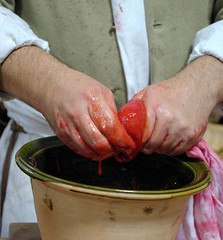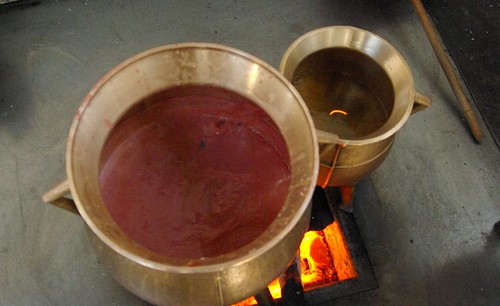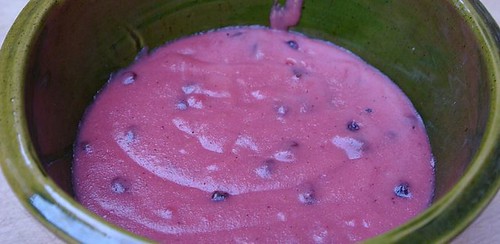So folks, here's another post from Robert.......enjoy!
Still on the 26th of September, I had better speed up a bit: there has been another weekend since my last post, so now I'm heading in both directions at once! Even the recipes that look simple, aren't...
Strawberye is basically strawberry juice thickened with flour. But let's take the first line, 'Take Strawberys, & waysshe hem in tyme of ere in gode red wyne'. Could mean wash before doing the other steps, or, as Marc H suggested, time of year; when they are ripe. And 'wash', sometimes a recipe says something like 'wash it clean', obviously the modern usage. Sometimes in the sense of 'clean' or pitted. Neither works in this case; perhaps some way to 'freshen up' the fruit? The wine being 'good' sounds rather like it's an ingredient.
Then 'strayne thorwe a clothe', Marc now does this by putting the damp strawberries whole in a cloth, really squeezing then twisting to get all the juice out.

'& do hem in a potte with with gode Almaunde mylke'. Right, now we have another recipe to look at! Marc made this from scratch, as there was a burner available, and he felt like it.
'To make gode almondys mylke', sugared water boiled and cooled for a bit, then add ground almonds. Of course it's a bit more complicated than this... Marc said it went milky very quickly this time. Pre-ground almonds were used.
Now the thickening part, 'a-lay it with Amyndoun other with flowre of Rys, & make it chargeaunt and lat it boyle'. A handful of rice flour was used. Sometimes there is a clue to the thickness; not so 'chargeaunt' so it can be poured from the bowl, for instance, but not in this case!

Then add currants, saffron, pepper, sugar ('grete plentie'), ginger, canel and galengale. Here we have another complication; 'canel'. This is usually taken to mean cinnamon. But there are recipes that call for cinnamon and canel...
We have wandered into an area that is being disputed by historic cooks. There are two candidates; proper cinnamon, delicate and sweet, and cassia, not so delicate and sweet. Both spices are mentioned in the bible, appearing together in an oil to anoint the ark, (no, not that ark, although some fragrance would have helped, I imagine...).
There is a fifteenth century hippocras recipe that has two versions; the 'lord's' has cinnamon, and the 'commoners'' has canel. Marc has adopted a zero-tolerance policy: always using cassia for 'canel'. One history of spice textbook, while examining in detail the cinnamon/cassia debate, sidesteps the issue by not even having 'canel' in the index. I expect the blog will go into a lot more detail about this as we go through the year: any comments?
Now, typically, punctuation complicates things. After the list of spices it continues 'poynte it with Vynegre, & a lytil whyte grece put ther-to; coloure it with Alkenade, & droppe it a-bowte, plante it with the graynys of Pome-garnad, & than serue it forth'. Reading the semi-colon in the modern way, the fat goes in with the spices and vinegar, and the whole thing coloured with alkanet. You need a lot of alkanet to change to strawberry colour... It does make more sense to colour the fat with the alkanet, which is fat soluble. Marc says the coloured drops of white fat should be strewn about the surface like glistening orangey/red jewels...

A good berry to choose, as Andrew Boorde says: 'Strawburyes, be praysed aboue al buryes for they do qualyfye the heate of the lyuer, & dothe ingender goode blode eaten with sugar'.
Yummy!
Along with all the above that Robert sent for posting, he also included the picture below.....I'm guessing from Halloween but it could just as well have been from the Palace Ghost Tour on the Sunday night......perhaps I should have asked him eh?
TTFN.


6 comments:
The cinnamon/cassia/canelle issue is rather intractable. I've got my notes on the issue online here, and they pretty much add up to complete uncertainty.
While there are recipes that link canelle with cassia, there are others that suggest that sometimes cassia was called cinnamon. Further, two dictionaries from 1611 both give somewhat self-contradictory definitions for the terms.
I think it's best to use whichever of the two spices you have on hand and prefer (which is what medieval cooks would have done), and the only time you can be sure of being right is when the recipe calls for both.
More importantly though, how did it taste? Did you serve it on its own, or as an accompaniment to another dish? Was it really that blasphemous, unnatural shade of red?
The real problem with whether they are seperate spices comes when you get bits like this in recipes
" caste also þer-to pouder Pepyr, & Macys, Clowes, Quybibys, pouder Canelle, Synamoun, & Salt, & a lytil Safroun" and it's not alone....just can't lay my hands on me Curye In Inglisch at the mo.
Marc H
As usual it was one of 5or6 on the table, tasted damn fine but then I'm biased as I made it, but the request for more from MrC's wife usually means it passed muster and yes it was that red.
Marc H
The recipe you're referring to is the one for Pompys from "Two Fifteenth-Century Cookery Books".
I like the creepy glow coming from the main gate! Really enjoyed the ghost tour xx
I posted this on the Flickr page but thought I'd do it here as well. Are the large dots of dark red the pomegranate seeds called for in the recipe or are they the coloured drops of white fat that Marc mentioned in the blog? I didn't see that there was any mention in Marc's account of adding the pomegranate seeds.
Post a Comment